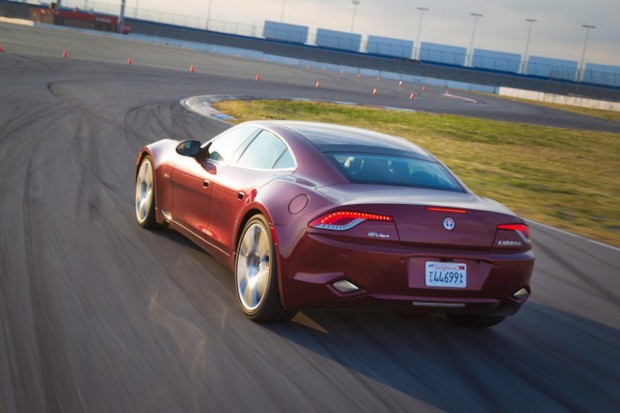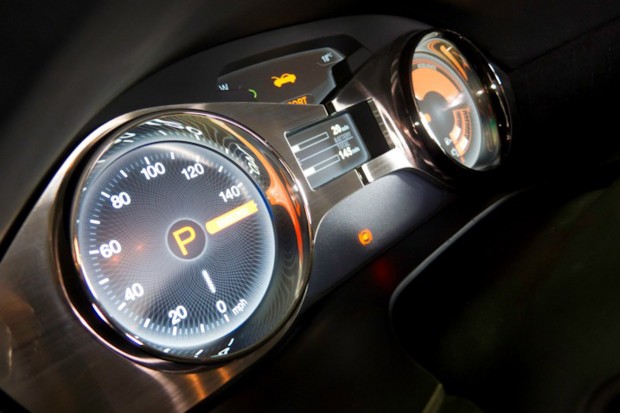
Looks like we were right about production beginning in March. The long awaited Fisker Karma was put to the test this week by a few automotive publications and they had a few good things to say about it.
For those of you who haven’t heard much about the Fisker Karma, let’s go over some of the important details.
#cgear
{
font-family: Arial, Helvetica, sans-serif;
width:100%;
border-collapse:collapse;
}
#cgear td, #cgear th
{
font-size:1.0em;
border-bottom:1px solid #cdcdcd;
padding:3px 2px 2px 3px;
}
#cgear th
{
font-size:1.1em;
text-align:left;
padding-top:5px;
padding-bottom:4px;
background: #95bad6 url(‘https://techcrunch.com/wp-content/uploads/2011/02/cg-auto-table.jpg’) repeat-x;
color:#fff;
}
#cgear tr.alt td
{
color:#000;
background-color: #e9e9e9;
}
| The Numbers | The Gear |
|---|---|
| Estimated Price: $95,000 | Powertrain: Rear-wheel drive, powered by two electric motors |
| Total Horsepower: 403 hp | Range Extender: 2-liter Turbo I4 |
| Total Torque: 981 lb-ft @ 0 rpm | Battery Type: 20 kW Lithium-ion |
| 0-60 mph: 7.9 sec (eco), 5.9 sec (sport) | Transmission Single-speed Auto |

From the looks of it, the Karma will be a neat car that can satisfy a niche market. Some of the test drivers had this to say about it:
Interior finish and materials quality are exceptional for this class and there is no cabin more ecologically conceived as this. The steering wheel is a tad overdone, though the thickness of the wheel itself is just right.
Central to the cabin’s controls is the standard 10.2-inch interface created with Visteon called the Fisker Command Center. All audio and climate controls are housed in the system, as are all general system tools and diagnostics. The touchscreen functionality appears fairly straightforward, although our interaction with it was limited.
Three years and a billion investment dollars after the Fisker Karma rolled forth as a stunning plug-in-hybrid concept, it’s finally ready to rock as a stunning production car. All in less time (and for far less money) than GM needed to produce the Chevy Volt.
The Karma’s initial surge is sufficiently potent to avoid damnation as a slug. But the physics conspire against it keeping pace with other $100K sports sedans. In spite of the joys of low-rpm electric torque, the realities of a curb weight well above 4000 pounds and only one gear ratio mean that mileage is where this car excels. Until the EPA weighs in on that subject, we can only guess that the Karma will land slightly below the Volt’s ratings of 93 equivalent mpg (MPGe) in electric driving and 35 mpg city and 40 highway with the engine running.
The 255-horsepower, 2.0-liter turbocharged and direct-injected GM Ecotec four-cylinder engine is cradled in a front mid-engine layout, and it powers the 175-kW generator while in Sport mode, which then pumps the 315-cell 606-pound lithium-ion battery pack full of kilowatt energy. It’s the 20-kW battery pack that finally feeds the two 201-hp, electric motors placed fore and aft of the single-speed rear differential. Combined, the whole works is good for a stonking 981 pound-feet of torque. Thus spinneth the rear axle and hence the forward thrust. In this Sport or, may we suggest, extended-range mode, top speed is let out to 125 mph and acceleration to 60 mph now happens in just 5.9 seconds whether we like it or not. We’ll come back to that.
Claimed maximum range in Sport mode is 300 miles. The fuel tank for the ER engine holds just 9.5 gallons, thus saving lots of sloshy pounds. Claimed possible autonomy per gallon in this longest range mode is 100+ miles, because you’ll definitely be recharging the batteries two or three times overnight before you burn through all the liquid fuel. Fisker predicts “people will stay in Stealth mode for over 80 percent of the time they’re driving.” A noble forecast, O, Danish wise man.
[via dailytech]

